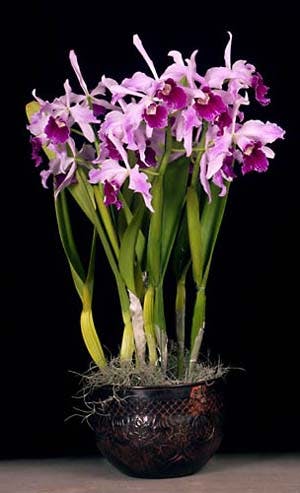Cattleya
The last of the spring-flowering types -- those that flower from a ripened hard pseudobulb -- will be finishing, while the first summer-blooming types will be showing buds on their rapidly growing, soft pseudobulbs. Both may need potting, as signaled by deteriorating mix, this month. The spring bloomers present no problems, as you will be dealing with fully ripe, well-hardened pseudobulbs. They will be ready to root on the mature front pseudobulb and will establish quickly. The summer bloomers, will be brittle and may be in bud. Nonetheless, experienced growers know that unless potted now, they may not root later, as this type tends to be seasonal in its rooting behavior. Stake the lead growth to avoid breakage. May can still present some changing light conditions that can lead to burning of the foliage if the plants have not been properly acclimatized. Allow them to build up their tolerance to higher light gradually. Changing light and temperatures can also be the source of some frustration when trying to determine when plants need watering. While cattleyas will be entering into a period of rapid growth starting this month, they have still not built up sufficient momentum to be significantly slowed by your missing a day or two of watering owing to dark weather. As always, it is safer to err on the dry side than on the wet. It is important, though, especially to the summer bloomers. Too much shade will cause rapidly developing inflorescences to droop unattractively.

Cattleya purpurata, formerly in the genus Laelia, is without a doubt one of the most stately orchids to bloom in this season. © G. Allikas
Paphiopedilum
The Paphiopedilum Maudiae types will be well into their season now, so a careful eye should be used toward staking. Do not be too anxious to stake, however. Many of this type, if staked too soon, will develop nodding flowers that do not face the observer. It is better to allow the flowers to ripen naturally, then support the spike right below the ovary for best display. This is especially common in Paphiopedilum fairrieanum-derived hybrids. If you have to do something when you first see the emerging spikes, just put the stake in the pot next to the spiking growth. Not only will this help you, but you will be able to see where the spikes are, so you can continue to pay attention to their development. The multifloral types will be entering their most active growth phase, so lots of light, water and fertilizer are called for to mature their large growths. Many will be spiking in the next couple of months, so be on the lookout for the emerging inflorescences. These may benefit from earlier staking than most, as the inflorescences grow so quickly in some cases that they can be quite soft. Again, best support is right below the ovary of the first flower. This will allow the most natural presentation of the blooms.

Paphiopedilum Maudiae types may need staking for best presentation
Phalaenopsis
Except for the latest-spiking plants, all phalaenopsis should be ready for potting or already potted. Because phalaenopsis are tropical plants, they tend to be seasonal in their rooting behavior. The critical point for potting is when new roots emerge from the base of the plant. This is absolutely the best time to repot a phalaenopsis. The summer-flowering types, based on Doritis background, have ideally already been potted and are becoming freshly established, ready to support their soon-to-emerge spikes for the summer season. Phalaenopsis potted at the right point in their growth cycle will reestablish almost immediately, with fresh roots growing into the new medium nearly uninterrupted. As soon as the flush of new root growth is seen, begin regular watering and fertilizing to make maximum use of the major growing season. Do not get over-exuberant with your watering, though, allowing water to splash between plants. This can be a source of infection for both water-borne pathogens and viral contamination. Phalaenopsis are much more susceptible to virus than was previously thought. Take extra care to keep your collection free of bacterial and viral problems, which you can accomplish by maintaining a clean growing area.
The AOS thanks Ned Nash and James Rose for this essay.









